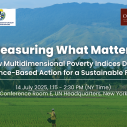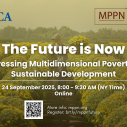
Search
Should disability be included in a multidimensional poverty measure?

Disability is a complex concept, which is usually misunderstood. In fact, different models to define disability exist, and in the last few decades the concept has evolved from understanding disability as a medical or individual perspective to a human rights one, where disability is the result of the interaction between a health condition and different social and attitudinal barriers.
In the last few decades, the recognition of people with disabilities as a vulnerable group that needs to be included in development strategies has increased. The Sustainable Development Goals for the first time explicitly mentioned people with disabilities as a vulnerable population and made a call for Member States to disaggregate data by disability status. Disability was explicitly mentioned in several of the 17 goals.
However, although people with disabilities constitute one of the most vulnerable populations in the world, and their individual characteristics are associated with poverty (e.g. low levels of education, low access to healthcare services, low rates of labour force participation, etc.), disability should not be understood as a cause or a consequence of poverty. Indeed, from a capability approach perspective, disability is the lack of practical opportunities available to a person with health limitations. In this context, people living with functional limitations become disabled only as a consequence of the lack of access to basic opportunities, which is the consequence of discrimination and social exclusion based on their health condition.
Measuring multidimensional poverty
In the process of designing a multidimensional poverty measure the selection of indicators is critical and one important and difficult stage. This stage identifies a list of aspects that define poverty and, in some cases, indicators are confused with aspects or characteristics usually related to poverty.
Health indicators are usually limited and, depending on the survey, these indicators can be restricted to a few questions, in most cases related to children’s health. There is not a clear definition of which indicators are associated with poor health for adults and how existent indicators can be included in a multidimensional poverty index. In this context, when questions related to health limitations or difficulties are included in the survey, having disability as an indicator is considered an option. However, are indicators related to health difficulties good indicators to include in a multidimensional poverty measure? And the answer is no.
There are several reasons why it is not a good indicator. First, people living with a disability face a higher risk of living in poverty, not because of their health conditions, but because of social and attitudinal barriers to participating equally in a society.
Second, although the levels of poverty of this group are higher, this does not mean disability should be negatively associated with poverty. In fact, the social movement on disability has worked to reduce the negative stereotype associated with disability and to increase awareness that disability is a situation that we all can face over the course of our lives and so society should be inclusive to people with different capabilities.
Third, to increase the recognition of disability and the visibility of this group in the public agenda, it is important to disaggregate multidimensional measures by disability status and to identify which are the most important deprivations this group faces. In this context, policy makers will have the information needed to define policies to reduce poverty and deprivation and to improve the lives of people with disabilities who are living in poverty or face different deprivations.
People living with a disability face a higher risk of living in poverty, not because of their health conditions, but because of social and attitudinal barriers to participating equally in a society.
In addition to the normative reasons why disability should not be included as an indicator of multidimensional poverty, there are technical reasons to consider. For example, when thinking about the characteristics of disability as an indicator, it is important to recognise that disability behaves as a stock indicator. When changes in multidimensional poverty over time are analysed, and disability has been included as an indicator, it is expected that no changes will be observed in this indicator as a result of public policy. In fact, it is expected that the prevalence of disability will increase over time, given increasing life expectancies and the increasing prevalence of chronic diseases. Therefore, this will be an indicator that cannot be affected by policies, which will increase for demographic reasons and that, even though it can be associated with ‘poor health’, this indicator does not reflect a health deprivation.
In conclusion, people with disabilities are a vulnerable group, who should be at the centre of the policy agenda. In this context, disability should not be an indicator of multidimensional poverty, instead, multidimensional poverty indices should be disaggregated by disability status, and attention should focus on the levels of poverty and deprivation of people with disabilities and their families in a society.
This article was published in Dimensions 11
















